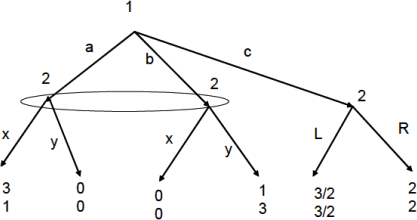Econ 4415: PS3
Hello, dear friend, you can consult us at any time if you have any questions, add WeChat: daixieit
Econ 4415: PS3
1. Consider the game in which the following stage game is repeated twice:

For each of the strategy profile for the stage game below, check if there is a subgame-perfect equilibrium in which players play that profile in the first round. (If the answer is Yes, construct such a subgame perfect equilibrium (SPE); otherwise explain why it is not possible.) [40pts]
(a) (C,L)
(b) (C,M)
(c) (C,R)
(d) (B,L)
2. Seagulls love shellfish. In order to break the shell, they need to fly high up and drop the shellfish. The problem is the other seagulls on the beach are kleptoparasites, and they steal the shellfish if they can reach it first. This question tells the story of two seagulls, named Irene and Jonathan, who live in a crowded beach where it is impossible to drop the shellfish and get it before some other gull steals it. The possible dates are t = 0; 1; 2; 3; . . .with no upper bound. Everyday, simultaneously Irene and Jonathan choose one of the two actions: "Up" or "Down". Up means to fly high up with the shellfish and drop it next to the other sea gull's nest, and Down means to stay down in the nest. Up costs c > 0, but if the other seagull is down, it eats the shellfish, getting payoff v > c. That is, we consider the infinitely repeated game with the following stage game:

They maximize the discounted sum of their stage payoffs with discount factor δ ∈ (0; 1). For each strategy profile below, find the set of discount factors δ under which the strategy profile is a subgame-perfect equilibrium.
(a) Irrespective of the history, Irene plays Up in the even dates and Down in the odd dates; Jonathan plays Up in the odd dates and Down in the even dates. [10 pts]
(b) Irene plays Up in the even dates and Down in the odd dates while Jonathan plays the other way around until someone fails to go Up in a day that he is supposed to do so. They both stay Down thereafter. [10pts]
(c) For n days Irene goes Up and Jonathan stays Down; in the next n days Jonathan goes Up and Irene stays Down. This continues back and forth until someone deviates. They both stay Down thereafter. [10pts]
(d) Irene goes Up on "Sundays", i.e., at t = 0; 7; 14; 21; . . ., and stays Down on the other days, while Jonathan goes up everyday except for Sundays, when he rests Down, until someone deviates; they both stay Down thereafter. [15pts]
(e) At t = 0, Irene goes Up and Jonathan stays Down, and then they alternate. If a seagull i fails to go Up at a history when i is supposed to go Up, then the next day i goes Up and the other seagull stays Down, and they keep alternating thereafter until someone fails to go Up when it is supposed to do so. (For example, given the history, if Irene is supposed to go Up at t but stays Down, then Irene goes Up at t + 1, Jonathan goes Up at t + 2, and so on. If Irene stays down again at t + 1, then she is supposed to go up at t + 2, and Jonathan is supposed to go at t + 3, etc.) [15pts]
3. Consider the extensive form game depicted in the following figure (where the payoff of player 1 is written on top, and the payoff of 2 is on the bottom).

(a) Write this game in normal form. Hint: a player's strategy is a com-plete contingent plan that tells him what to play at each of his infor-mation sets. (10 pts)
(b) Find all Nash equilibria of the normal-form game that you find in (a). (10 pts)
4. Consider the following extensive-form game:

(a) Solve the game by backward induction. (10 pts)
(b) Find all pure-strategy Nash equilibria (in complete contingent plans) of this extensive-form game. You do not need to write down the normal-form representation. (10 pts)
2021-11-21